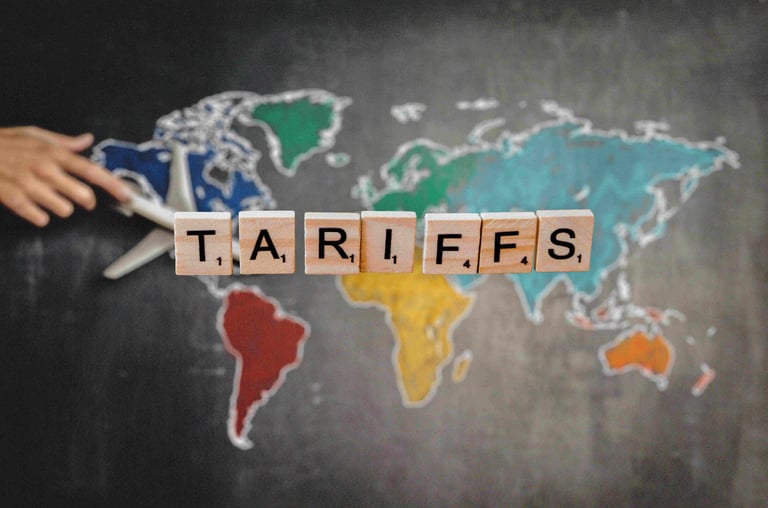
Easily Understand Your Finances With The Financial Health Check Template Today
What are Tariffs and How Could They Affect Your Creative Business?
Learn how tariffs impact creative businesses, from increased costs to supply chain disruptions, and strategies to adapt. Essential reading for entrepreneurs.
BUSINESSECONOMYTAX
David Kindness, CPA
3/25/2025



What are Tariffs and How Could They Affect Your Creative Business?
Published on March 24, 2025
Written by David Kindness, CPA
Why you can trust Your Creative CPA
Our content is written, edited, or both by industry experts who are creative entrepreneurs just like you. Learn more.
Tariffs have become a hot topic since Donald Trump’s second inauguration on January 20, 2025, especially for businesses that rely on international trade. Whether you’re a small creative business importing materials, a drop shipper selling merch, or a larger enterprise importing and exporting products, understanding tariffs is crucial.
This article will explain what tariffs are, how they work, and their potential impact on your creative business. We’ll also explore the specific tariffs introduced during the Trump administration and their effects on various industries.
Fast Facts About Tariffs
Tariffs are taxes on imported goods from foreign countries.
Tariffs are typically imposed on commodities such as raw materials, energy, agricultural products, technology and more.
Tariffs can have broad effects on economies, businesses, taxes, and individuals.
Over time, tariffs can replace a portion of traditional taxes on income, property, sales, and capital gains, lowering those taxes proportionally.
What are Tariffs?
Tariffs are taxes imposed by governments on imported goods and services. They are designed to generate tax revenue and protect domestic industries by making foreign products more expensive, thereby encouraging consumers to buy locally produced items. Tariffs can be specific (a fixed fee per unit) or ad valorem (a percentage of the item’s value).
Tariffs can significantly impact the cost of materials, tools, and equipment sourced from abroad. For example, if you’re a creative who runs a handmade jewelry business and imports metals, beads, or jewels, tariffs could increase your production costs, forcing you to either absorb the expense or pass it on to your customers.
However, the ideal implementation of tariffs would result in an increase in product costs being offset by a reduction in taxes paid by businesses and individuals. More on that later on.
! "Domestic" refers to goods or services produced within a certain country. For example, goods produced in the US are domestic to the US.
Trump’s Tariffs
In the months leading up to his second presidency, Trump announced that he would be implementing tariffs as part of the America First trade policy. These tariffs are primarily aimed at reducing the U.S. trade deficit, encouraging production and manufacturing within the United States, and protecting domestic industries from foreign competition.
The following tariffs are in effect as of the publication of this article:
25% tariff on imports from Canada
25% tariff on imports from Mexico
20% tariff on imports from China
What Industries Will Tariffs Affect?
To determine what industries current tariffs will impact, let’s explore what materials the US imports from Canada, Mexico, and China…
What Does the US Import From Canada?
The US imports the following products from Canada:
Energy Products: Canada is the largest supplier of crude oil and natural gas, which are critical for fueling industries, transportation, and households across the country.
Vehicles and Automotive Parts: Finished vehicles such as cars, trucks, cargo vans, and industrial vehicles, as well as a variety of automotive parts.
Machinery and Equipment: Industrial machinery, engines, and specialized equipment which support manufacturing and construction sectors.
Agricultural Products: agricultural goods like meat, dairy products, and grains, which complement domestic food supplies.
Wood and Paper Products: Canada is a leading supplier of lumber, wood pulp, and paper products, which are essential for the construction and publishing industries.
In 2024, imports to the US from Canada totaled approximately $412.7 billion. A 25% tariff on this amount would equal roughly $103.2 billion.

Tariffs are taxes on imported goods from foreign countries. They're typically imposed on commodities such as raw materials, energy, agricultural products, and technology.

What Does the US Import From Mexico?
The US imports the following products from Mexico:
Vehicles and Automotive Parts: Cars, trucks, and automotive components, which are part of the highly integrated automotive industry across North America, with many vehicles and parts crossing the border multiple times during production.
Electrical Machinery and Equipment: Computers, televisions, phones, and telecommunications equipment, which are essential for consumer and industrial use.
Medical Devices and Pharmaceuticals: Medical instruments, equipment, and pharmaceutical products, which play a critical role in supporting the healthcare sector.
Agricultural Products: Fresh produce like avocados, tomatoes, berries, and peppers from Mexico. Additionally, beverages such as beer and tequila are popular imports.
Textiles and Apparel: Textiles, clothing, footwear, and accessories. Many US brands rely on Mexican manufacturing for affordable and high-quality apparel.
Oil and Gas: While not as significant as Canada, Mexico also supplies the US with crude oil and refined petroleum products, contributing to the US energy supply.
In 2024, imports to the US from Mexico totaled approximately $505.9 billion. A 25% tariff on this amount would equal roughly $126.5 billion.
What Does the US Import From China?
The US imports the following products from China:
Electronics and Technology: Consumer electronics, including smartphones, laptops, tablets, and televisions, plus commercial components like semiconductors, circuit boards, and batteries.
Machinery and Equipment: Industrial machinery, including computers, engines, and manufacturing equipment, which support the construction, agriculture, and technology industries.
Apparel and Footwear: Clothing, shoes, and accessories, from low-end to high-end. Many US fashion brands and retailers rely on Chinese manufacturing for affordable and high-volume production.
Toys and Games: A large portion of toys, games, and sporting goods sold in the US are manufactured in China. This includes everything from action figures and board games to outdoor equipment.
Furniture and Home Goods: The US imports furniture, lighting, and home decor items from China. These products are popular among consumers and businesses alike, offering affordable options for home and office use.
Plastics, Rubber, Metal, and Wood Products: China exports a wide range of plastic, rubber, metal, and wood products, including packaging materials, household items, and industrial components.
Pharmaceuticals and Medical Supplies: While not as dominant as other categories, China also supplies the US with pharmaceuticals, medical devices, and personal protective equipment (PPE).
In 2024, imports to the US from China totaled approximately $438.9 billion. A 20% tariff on this amount would equal roughly $87.8 billion.
Effects of Tariffs
Tariffs can have far-reaching consequences for individuals, businesses, and entire economies. Let’s explore how tariffs impact economies, businesses, and taxes.
How do Tariffs Affect Economies?
Trade Wars: Tariffs often lead to retaliatory measures from other countries, sparking trade wars. For example, China responded to U.S. tariffs by imposing duties on American agricultural products.
Price Increases: Higher import costs can lead to increased prices for consumers.
Economic Growth: While tariffs may protect certain industries, they can also stifle economic growth by reducing trade volumes and increasing costs for businesses.
How do Tariffs Affect Businesses?
Increased Costs: Businesses that rely on imported materials face higher production costs, which can squeeze profit margins.
Supply Chain Disruptions: Tariffs can disrupt global supply chains, forcing businesses to find alternative suppliers or absorb additional costs.
Competitiveness: Higher costs could make it harder for businesses to compete with foreign companies that aren’t subject to the same tariffs.
How do Tariffs Affect Taxes?
Consumer Taxes: Tariffs are essentially taxes on imports, which can lead to decreased income, capital gains, property, sales, or use tax for consumers.
Corporate Taxes: Tariffs may replace a portion of business income taxes, lowering taxes for businesses. However, higher operational costs may reduce taxable income and taxes due.
Retaliatory Taxes: Other countries may impose their own tariffs on U.S. exports, affecting businesses that sell internationally.
Conclusion
Tariffs are a powerful tool in international trade, but they come with significant consequences. For creative businesses, understanding how tariffs work and their potential impact is essential for navigating the complexities of global commerce.
Whether you’re importing materials, exporting products, or simply trying to decrease costs and stay competitive, staying informed about tariff policies can help you make better decisions for your business.
Frequently Asked Questions (FAQs)
What is HS Code?
The Harmonized System (HS) Code is an internationally standardized system of names and numbers used to classify traded products. It helps customs authorities identify goods and apply the correct tariffs. For example, if you’re importing silk fabric for your fashion business, you’ll need to know the specific HS Code to determine the applicable tariff rate.
How Can Creative Businesses Mitigate the Impact of Tariffs?
Creative businesses can mitigate the impact of tariffs by:
Sourcing Locally: Reduce reliance on imported materials by finding domestic suppliers. This can also help support small, local businesses.
Diversifying Suppliers: Avoid dependence on a single country by sourcing from multiple regions.
Adjusting Pricing: Strategically increase prices to offset higher costs without losing customers.
Are Tariffs Permanent?
No, tariffs are not necessarily permanent. They can be adjusted, removed, or replaced based on the introduction of new laws, trade negotiations, political decisions, or changes in economic conditions. For example, the U.S. and China have periodically revised their tariff policies as part of ongoing trade talks.
Disclaimer: the information provided in this article is for educational purposes only and does not constitute tax, accounting, investing, legal, or financial advice. The information in this article does not take into account your unique financial or business situation or goals, and YCCPA cannot be responsible for reader's financial decision-making. YCCPA's goal is to educate and support you on your creative business journey.
Written by David Kindness, CPA
David is a CPA (Certified Public Accountant) and professional photographer, videographer, and designer based in San Diego, California. Learn more.
Supported by Ads
Your Creative CPA is supported by the ads you may see in our articles and guides. These ads help us serve creatives like you.







financial wisdom for creatives, by creatives

Created by David Kindness
© 2025 Your Creative CPA | Terms
type1wild.com partner
Exclusive guides and tools for creatives, right to your inbox.









